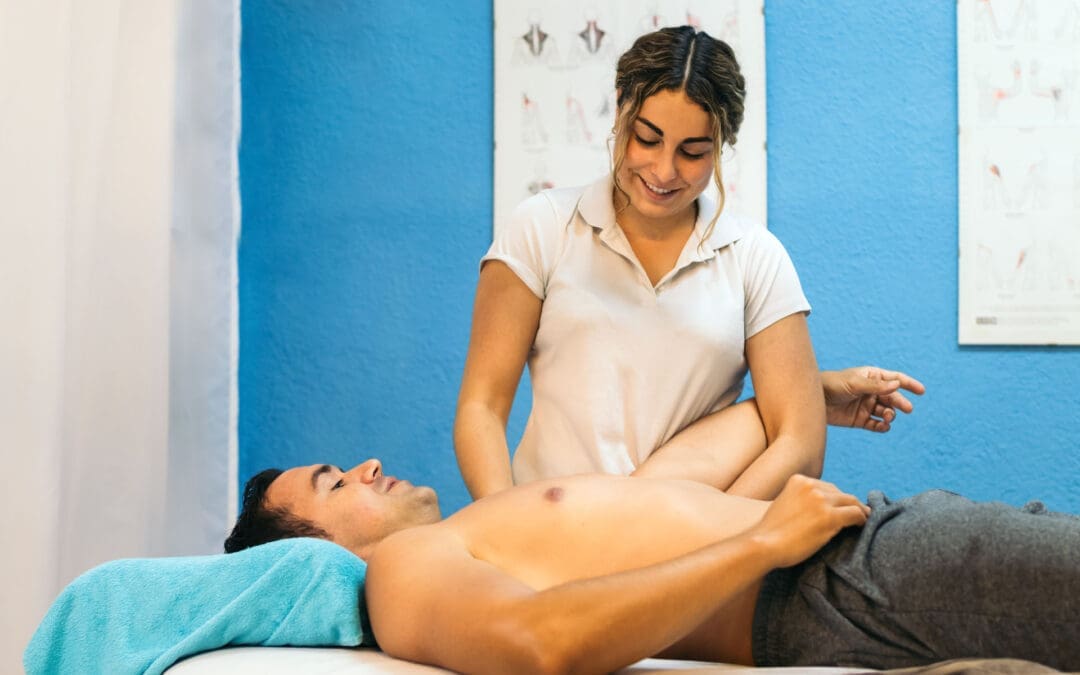Contents
How Massage Therapy Supports El Paso Back Clinic’s Integrative Back & Injury Care

Massage therapy is far more than relaxation. In places like El Paso Back Clinic, it is a central part of healing after injury, especially when combined with advanced diagnostics, chiropractic care, and functional medicine. This article explains how therapists are trained to use proper body mechanics and a range of techniques to deliver variable pressure safely and effectively—and how that fits specifically within the services and philosophy at El Paso Back Clinic.
El Paso Back Clinic: Philosophy & Local Context
El Paso Back Clinic is led by Dr. Alexander Jimenez, DC, APRN, FNP-BC, CFMP, IFMCP. The clinic offers injury care, sports wellness, functional medicine, nutritional labs, accident & trauma rehabilitation, and more. Their goal is not only to reduce pain but also to restore function, improve long-term health, and empower patients. (El Paso Back Clinic® • 915-850-0900)
Given El Paso’s climate, traffic patterns, high incidence of work and motor vehicle injuries, and populations often facing musculoskeletal stresses (from physical labor, commute, environmental heat), having a clinic that combines hands-on care (like massage and chiropractic) plus diagnostics, nutrition, and rehabilitation gives patients a more complete path to recovery.
How Massage Therapists Are Trained at El Paso Back Clinic
At El Paso Back Clinic, massage therapists (or hands-on therapists) receive training in:
- Anatomy & injury types: Understanding soft tissue, fascia, muscles, ligaments, joint mechanics, nerve irritation, and the healing stages after trauma.
- Techniques with varying pressure levels include Swedish massage for light pressure, myofascial release, trigger point work, deep tissue strokes, and sports massage. The therapist must know when to adjust pressure and technique based on the patient’s needs.
They also learn body mechanics, which includes:
- Using stable positions (such as lunges, with aligned shoulders and hips, and a stable base) to deliver pressure using body weight instead of relying purely on arm strength.
- Keeping joints aligned to avoid strain: wrists, elbows, shoulders, and hips.
- Engaging core muscles and using forearms or elbows when deeper pressure is needed, rather than overusing small muscles or risking repetitive strain injuries.
These practices help ensure therapists can deliver light, medium, or very deep pressure safely and consistently.
Variable Pressure: Light, Medium, and Deep
One of the strengths of El Paso Back Clinic is tailoring the pressure to the patient’s condition. Key considerations:
- Stage of injury
- Immediately after injury (e.g., whiplash, auto collision, work accident), there is often swelling, sensitivity, nerve irritation, or inflammation. Therapists start with lighter pressure to ease muscle guarding and improve circulation without causing further trauma.
- As healing progresses, they gradually increase to medium or deeper pressure to break down adhesions, improve tissue mobility, release trigger points, and facilitate proper alignment.
- Patient feedback
- Therapists continually check with the patient (pain levels, comfort, tolerance). If pressure hurts more than helps, it is adjusted.
- The use of pain or discomfort scales, or sometimes comparison between sides, helps map out what level of pressure works.
- Treatment goals
- For relaxation, circulation, or early healing: lighter pressure;
- For chronic tightness, scar tissue, longer-term dysfunction: deeper work;
- For preparing for chiropractic adjustments or rehabilitation exercises, pressure is sufficient to loosen soft tissue tension without aggravation.
- Tools & technique
- Use of elbows, forearms, or specialized tools when deeper pressure is needed so the therapist avoids wearing out hands and joints.
- Sustained pressure (holding a spot) vs. lighter strokes; slow increments rather than sudden, strong force.
How Massage Fits into El Paso Back Clinic’s Injury & Rehabilitation Protocols
El Paso Back Clinic integrates massage therapy into its broader care model, which includes:
- Chiropractic adjustments: After a massage relaxes tight muscles and soft tissue, chiropractic manipulation or spinal adjustments can be more effective because tissues are less resistant and joints can move more freely.
- Diagnostic imaging & functional assessments: Before and during treatment, the clinic utilizes imaging (X-ray, MRI if necessary), laboratory and blood studies, functional movement assessments, and neurological examinations. These help identify which tissues to treat, where deeper pressure might be risky, and how far to push therapy. (El Paso Back Clinic® • 915-850-0900)
- Functional Medicine & Nutrition: Pain, inflammation, and healing are influenced not only by what happens at the injury site but also by systemic factors, including nutrition, inflammation, metabolic health, sleep, and stress. The clinic evaluates these and includes them in plans, so massage and chiropractic care are supported from the inside. (El Paso Back Clinic® • 915-850-0900)
- Rehabilitation & Movement Training: A range of exercises, including range of motion, strength training, posture correction, flexibility, and agility work, all help maintain gains from therapy and prevent re-injury. Massage reduces muscle tightness and improves mobility, which makes rehab exercises more effective.
- Auto Injury / Trauma / Legal Documentation: For patients with motor vehicle accidents, whiplash, or other collision injuries, the clinic documents condition (soft tissues, alignment, neurologic signs), imaging findings, treatment plans, responses to massage, and other modalities. This documentation is essential to support insurance or legal claims. (El Paso Back Clinic® • 915-850-0900)
Clinical Observations & Outcomes at El Paso Back Clinic
From Dr. Jimenez’s experience and the clinic’s outcomes:
- Patients who start hands-on therapy (massage) early, combined with chiropractic and functional medicine, often show quicker reduction in pain and better range of motion.
- Deep pressure techniques are only introduced when imaging or assessment indicates it is safe (i.e., no unresolved inflammation, no acute nerve compression).
- Many patients report better sleep, less muscle soreness, improved posture, and fewer flare-ups when massage is integrated regularly rather than used only in emergency phases.
- Use of body mechanics in massage therapy helps therapists avoid fatigue and maintain consistency over a full course of care, which helps patient outcomes remain steady.
Safety, Communication, & Patient Empowerment
Safety is a big priority. The clinic ensures that:
- Therapists communicate: asking about pressure, pain, any aggravations, or sensitivities.
- Pressure is adjusted immediately if something doesn’t feel right.
- Therapists use posture, leverage, and tools properly — so patients are treated safely and therapists avoid injury.
- Patients are educated on self-care, stretches, ergonomics, and posture to sustain the benefits of therapy.
Conclusion
El Paso Back Clinic uses massage therapy not as an add-on, but as a vital part of an integrative, evidence-based healing pathway. Through professional training, variable pressure techniques, good body mechanics, diagnostics, chiropractic care, functional medicine, and legal documentation, the clinic offers patients in El Paso a full spectrum of recovery—not just temporary pain relief, but restored function, strength, and long-term wellness.
If you are recovering from a back injury, auto accident, work or sports trauma, or chronic pain, El Paso Back Clinic’s model may be what helps you return to normal life safely and fully.
References
-
American Massage Therapy Association. (2021). Work smarter, not harder.
-
East West College. (2021). The different skills that a full-fledged massage therapist must have.
-
Hand in Health Massage Therapy. (2021). Deep tissue massage: How deep is too deep?.
-
Live Well Health & Physiotherapy. (2021). Difference between massage therapy and spa massage.
-
Madison Better Body. (2022). Body mechanics in massage.
-
Madison Better Body. (2023). Types of massage pressure.
-
Massage Capital. (2021). How much pressure is too much when getting a massage?.
-
Massage Magazine. (2022). How to easily measure your pressure in deep tissue massage.
-
Mayo Clinic Health System. (2021). Benefits of massage therapy.
-
Reddit. (2021a). How much pressure is too much pressure?.
-
Reddit. (2021b). Need advice from a licensed massage therapist on what level of pressure to use.
-
Target Therapies. (2022). Relaxing full body massage.
-
The Clinic Health Group. (2022). What massage pressure is right for you?.
-
El Paso Back Clinic. (n.d.). Welcome to El Paso Back Clinic
General Disclaimer, Licenses and Board Certifications *
Professional Scope of Practice *
The information herein on "Massage Therapy Injury Recovery Techniques" is not intended to replace a one-on-one relationship with a qualified health care professional or licensed physician and is not medical advice. We encourage you to make healthcare decisions based on your research and partnership with a qualified healthcare professional.
Blog Information & Scope Discussions
Welcome to El Paso's Premier Wellness and Injury Care Clinic & Wellness Blog, where Dr. Alex Jimenez, DC, FNP-C, a Multi-State board-certified Family Practice Nurse Practitioner (FNP-BC) and Chiropractor (DC), presents insights on how our multidisciplinary team is dedicated to holistic healing and personalized care. Our practice aligns with evidence-based treatment protocols inspired by integrative medicine principles, similar to those on this site and on our family practice-based chiromed.com site, focusing on naturally restoring health for patients of all ages.
Our areas of multidisciplinary practice include Wellness & Nutrition, Chronic Pain, Personal Injury, Auto Accident Care, Work Injuries, Back Injury, Low Back Pain, Neck Pain, Migraine Headaches, Sports Injuries, Severe Sciatica, Scoliosis, Complex Herniated Discs, Fibromyalgia, Chronic Pain, Complex Injuries, Stress Management, Functional Medicine Treatments, and in-scope care protocols.
Our information scope is multidisciplinary, focusing on musculoskeletal and physical medicine, wellness, contributing etiological viscerosomatic disturbances within clinical presentations, associated somato-visceral reflex clinical dynamics, subluxation complexes, sensitive health issues, and functional medicine articles, topics, and discussions.
We provide and present clinical collaboration with specialists from various disciplines. Each specialist is governed by their professional scope of practice and their jurisdiction of licensure. We use functional health & wellness protocols to treat and support care for musculoskeletal injuries or disorders.
Our videos, posts, topics, and insights address clinical matters and issues that are directly or indirectly related to our clinical scope of practice.
Our office has made a reasonable effort to provide supportive citations and has identified relevant research studies that support our posts. We provide copies of supporting research studies upon request to regulatory boards and the public.
We understand that we cover matters that require an additional explanation of how they may assist in a particular care plan or treatment protocol; therefore, to discuss the subject matter above further, please feel free to ask Dr. Alex Jimenez, DC, APRN, FNP-BC, or contact us at 915-850-0900.
We are here to help you and your family.
Blessings
Dr. Alex Jimenez DC, MSACP, APRN, FNP-BC*, CCST, IFMCP, CFMP, ATN
email: coach@elpasofunctionalmedicine.com
Multidisciplinary Licensing & Board Certifications:
Licensed as a Doctor of Chiropractic (DC) in Texas & New Mexico*
Texas DC License #: TX5807, Verified: TX5807
New Mexico DC License #: NM-DC2182, Verified: NM-DC2182
Multi-State Advanced Practice Registered Nurse (APRN*) in Texas & Multi-States
Multi-state Compact APRN License by Endorsement (42 States)
Texas APRN License #: 1191402, Verified: 1191402 *
Florida APRN License #: 11043890, Verified: APRN11043890 *
License Verification Link: Nursys License Verifier
* Prescriptive Authority Authorized
ANCC FNP-BC: Board Certified Nurse Practitioner*
Compact Status: Multi-State License: Authorized to Practice in 40 States*
Graduate with Honors: ICHS: MSN-FNP (Family Nurse Practitioner Program)
Degree Granted. Master's in Family Practice MSN Diploma (Cum Laude)
Dr. Alex Jimenez, DC, APRN, FNP-BC*, CFMP, IFMCP, ATN, CCST
My Digital Business Card
Licenses and Board Certifications:
DC: Doctor of Chiropractic
APRNP: Advanced Practice Registered Nurse
FNP-BC: Family Practice Specialization (Multi-State Board Certified)
RN: Registered Nurse (Multi-State Compact License)
CFMP: Certified Functional Medicine Provider
MSN-FNP: Master of Science in Family Practice Medicine
MSACP: Master of Science in Advanced Clinical Practice
IFMCP: Institute of Functional Medicine
CCST: Certified Chiropractic Spinal Trauma
ATN: Advanced Translational Neutrogenomics
Memberships & Associations:
TCA: Texas Chiropractic Association: Member ID: 104311
AANP: American Association of Nurse Practitioners: Member ID: 2198960
ANA: American Nurse Association: Member ID: 06458222 (District TX01)
TNA: Texas Nurse Association: Member ID: 06458222
NPI: 1205907805
| Primary Taxonomy | Selected Taxonomy | State | License Number |
|---|---|---|---|
| No | 111N00000X - Chiropractor | NM | DC2182 |
| Yes | 111N00000X - Chiropractor | TX | DC5807 |
| Yes | 363LF0000X - Nurse Practitioner - Family | TX | 1191402 |
| Yes | 363LF0000X - Nurse Practitioner - Family | FL | 11043890 |








